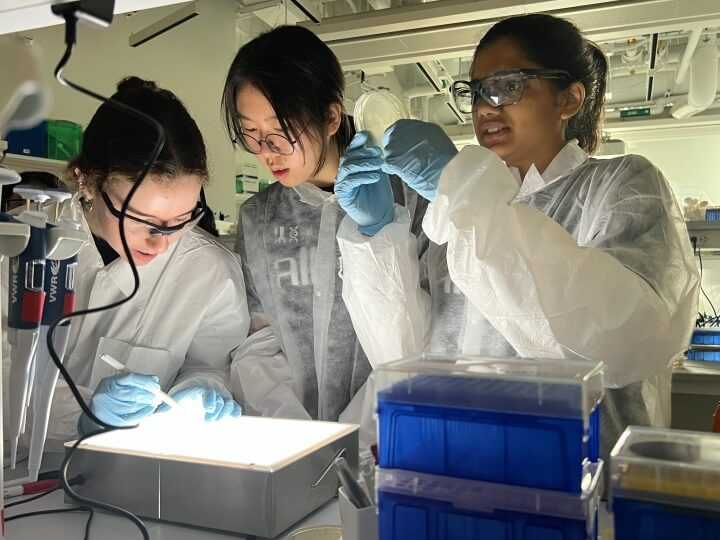
In a groundbreaking initiative, Harvard, MIT, and Mass General Brigham have formed a pioneering renewable energy collaboration aimed at transforming how institutions engage with sustainable energy sources. This consortium, known as the Consortium for Climate Solutions, strategically unites higher education, healthcare, and cultural institutions to leverage their collective buying power, facilitating significant and cost-effective clean energy projects. With the ambition to purchase 100% of their electricity from renewable sources by 2026, these organizations are committed to tackling climate change head-on while setting a powerful example for others. This partnership also opens doors for smaller nonprofits and municipalities to participate in the clean energy movement, ensuring broader access to sustainable solutions. By investing in large-scale renewable energy projects like the Big Elm Solar and Bowman Wind initiatives, the consortium is not only advancing local sustainability goals but making a substantial impact on national emissions reduction efforts.
The recent formation of a coalition focused on sustainable energy generation brings a fresh wave of optimism for the advancement of eco-friendly solutions in various sectors. This innovative partnership, which includes prominent institutions like Harvard and MIT, focuses on establishing collaborative frameworks that enhance the efficiency and effectiveness of clean electricity initiatives. By uniting educational and healthcare institutions, as well as cultural entities, this alliance aims to address the pressing challenges posed by climate change through joint investment in renewable resources. Such collaborative efforts provide an opportunity for diverse organizations to engage with and benefit from renewable energy markets, paving the way for broader involvement in clean energy projects. Emphasizing shared goals, this consortium embodies a cooperative spirit that could inspire similar movements across the nation.
The Formation of the Consortium for Climate Solutions
The Consortium for Climate Solutions was introduced as a groundbreaking initiative designed to foster collaborative efforts in the realm of renewable energy. Spearheaded by notable institutions like Harvard, MIT, and Mass General Brigham, this consortium brings together educational, healthcare, and cultural organizations, coupling their resources to advance sustainability. By leveraging their combined purchasing power, these member institutions aim to break down existing market barriers that impede the growth of renewable energy projects. This innovative approach not only addresses local energy needs but also sets a benchmark for how collaboration can lead to larger environmental impacts.
One of the pivotal goals of the consortium is to promote the development of cost-effective and scalable renewable energy solutions. The members are focused on aligning their strategies to create a sustainable energy future while fulfilling specific sustainability goals. For example, Harvard’s commitment to purchasing 100% of its electricity from renewable sources by 2026 is a testament to the consortium’s capability to push the boundaries of traditional energy-buying practices, accordingly fostering a culture of sustainability among some of the most influential institutions in the region.
Renewable Energy Projects Making an Impact
Recently, the partnership executed negotiations that will culminate in the establishment of two major renewable energy projects: the Big Elm Solar Project in Texas and the Bowman Wind Project in North Dakota. These projects collectively represent an ambitious stride towards achieving major sustainability milestones by generating substantial clean energy equivalent to powering 130,000 homes annually. The successful implementation of these projects is critical for meeting local and national energy demands, particularly as reliance on fossil fuels continues to threaten environmental health.
The Big Elm and Bowman projects are strategically located within some of the most challenging carbon-intensive electrical grid regions in the United States, highlighting the essential role these renewable projects serve in reducing fossil fuel dependencies. As the consortium members integrate these projects into their energy frameworks, they not only address their individual sustainability targets but also contribute to a nationwide shift towards cleaner energy sources that will have lasting effects on public health, climate resilience, and ecosystem stability.
Harnessing Collective Impact for Sustainable Solutions
The creation of such a consortium is a powerful example of how organizations can collaborate to maximize their collective impact in the fight against climate change. By joining forces, Harvard, MIT, and Mass General Brigham are not only leading by example but also enabling smaller nonprofits and municipalities to access renewable energy solutions that were once beyond their financial reach. This collaboration has resulted in significant partnerships with organizations like PowerOptions, which empowers members to obtain large-scale renewable energy contracts, fostering sustainability across a broader community.
The consortium’s initiatives have profound implications for local and state climate strategies. By piloting programs that allow various institutions to band together, the model showcases how coordinated efforts can tackle regional challenges and enhance overall energy efficiency. The feasibility of affordable renewable energy that results from this collaboration could pave the way for additional clean energy projects across the country, ultimately contributing to the overarching goal of reducing greenhouse gas emissions and moving toward a fossil fuel-free future.
Leveraging Resources to Tackle Climate Change
The consortium’s strategic alignment extends beyond just renewable energy projects; it encompasses a holistic approach to addressing climate change through collaborative resource management. Institutions involved are committed to investing in technology and infrastructure that foster sustainable energy solutions, including energy efficiency enhancements and electric vehicle integration within their fleets. This comprehensive approach addresses immediate energy needs while preparing for long-term environmental improvements, reiterating the importance of cooperation in combating climate change.
As Harvard takes strides toward its fossil fuel-neutral target by 2026, the lessons learned from this consortium could serve as a guide for similar initiatives nationally and globally. The focus on combining financial resources to access clean energy exemplifies how partnerships can shape a more sustainable future for all stakeholders involved, including community members and the environment. This framework not only provides immediate benefits but also enhances the resilience of organizations against the escalating impacts of climate change.
The Role of Educational Institutions in Sustainability
Educational institutions like Harvard and MIT play a vital role in shaping sustainability practices and modeling renewable energy initiatives for a wider audience. Their established reputation as leaders in research and innovation, particularly in renewable energy, sets the stage for meaningful advancements in climate solutions. The formation of the Consortium for Climate Solutions highlights how these institutions can synthesize academic rigor with practical application, driving forward-thinking climate action.
Moreover, training and educating future leaders in sustainability through their respective programs strengthens the workforce dedicated to addressing climate challenges. Initiatives within these educational institutions often result in groundbreaking research while fostering a culture of sustainability that spills over into wider communities. The consortium effectively exemplifies how collaboration in higher education can ignite changes that resonate beyond the campus, inspiring actionable results far into the future.
Health Sector Engagement in Climate Solutions
The involvement of health sector institutions like Mass General Brigham in the consortium emphasizes the integral link between public health outcomes and sustainable energy practices. Healthcare providers recognize the detrimental impacts that fossil fuel usage has on community health, particularly in vulnerable populations. Their participation reinforces the need for clean energy innovations to improve air quality and reduce pollution-related health issues.
By advocating for the integration of renewable energy resources, the health sector not only aligns its operational principles with environmental stewardship but also enhances the resilience of healthcare systems against future climate-related challenges. This proactive engagement is crucial, as a healthy population is directly linked to a cleaner environment, ultimately contributing to the effectiveness of sustainability initiatives curated by the consortium.
Expanding Access to Clean Energy Solutions
The consortium’s collaboration allows members to access large-scale renewable energy projects that would otherwise be unattainable individually. This cooperative strategy is instrumental in democratizing clean energy resources, enabling smaller nonprofits and local governments to thrive sustainably. Through initiatives like PowerOptions, consortium members gain financial leverage that translates into securing more affordable energy solutions.
Expanding access to clean energy solutions is essential for addressing the challenges of climate change while simultaneously fulfilling local sustainability goals. The consortium’s model not only serves immediate energy demands but also encourages innovative practices among its members, showcasing that collective action can lead to lasting economic and environmental benefits. This pattern of collaboration is expected to inspire others in the pursuit of similar initiatives for a greener planet.
Driving Innovation Through Sustainable Partnerships
The partnership established through the Consortium for Climate Solutions illustrates the transformative potential of innovative collaboration. By fostering alliances among educational institutions, healthcare organizations, and cultural entities, the consortium champions novel approaches to renewable energy projects and climate change adaptation strategies. This method of engaging diverse stakeholders is fundamental to addressing the complex problem of climate change and creating scalable solutions.
Additionally, this model of partnership encourages shared learning and resource optimization. By collaboratively investing in renewable energy technologies and sustainability initiatives, consortium members are better positioned to create a robust foundation for future projects. This collaborative spirit enhances innovation, inspiring other organizations to join forces and amplify their efforts towards achieving a clean energy future.
A Roadmap for Future Sustainability in Higher Education
The initiative and ongoing commitment of the Consortium for Climate Solutions provides a clear roadmap for integrating sustainability within higher education frameworks. As colleges and universities aspire to become leaders in responding to climate challenges, the lessons learned from this consortium can help formulate effective strategies that emphasize collective action and collaboration.
By setting ambitious renewable energy targets and actively pursuing innovative projects, the consortium not only influences institutional practices but also serves as a guide for other educational facilities. This roadmap becomes essential in shaping educational policies and fostering environmentally conscious citizens who can contribute to the global sustainability agenda.
Frequently Asked Questions
What is the purpose of the Harvard-MIT-Mass General renewable energy collaboration?
The purpose of the Harvard-MIT-Mass General renewable energy collaboration, known as the Consortium for Climate Solutions, is to leverage the collective purchasing power of institutions to invest in cost-effective renewable energy projects. This initiative aims to facilitate the transition to a clean energy future while tackling climate change by overcoming market barriers.
How does the Consortium for Climate Solutions support clean energy projects?
The Consortium for Climate Solutions supports clean energy projects by pooling resources from its members—Harvard, MIT, and Mass General Brigham—allowing smaller nonprofits and municipalities access to large-scale renewable energy purchases. This collaborative approach enables participants to achieve their sustainability goals more effectively and economically.
What kind of renewable energy projects are involved in the collaboration?
The collaboration focuses on large-scale renewable energy projects, such as the Big Elm Solar Project in Texas and the Bowman Wind Project in North Dakota, which together will produce 408 megawatts of clean energy. These projects are designed to meet the energy needs of numerous member organizations while furthering their commitment to sustainability.
How will Harvard’s renewable energy collaboration impact its goal of fossil fuel neutrality by 2026?
Harvard’s renewable energy collaboration aims to achieve fossil fuel neutrality by purchasing 100% of its electricity from renewable sources as a key step. This is part of a broader strategy that includes enhancing energy efficiency and transitioning to sustainable technology by the year 2026.
What role does PowerOptions play in the renewable energy collaboration?
PowerOptions plays a crucial role in the renewable energy collaboration by acting as a nonprofit energy-buying organization that connects various member institutions, such as the city of Cambridge and numerous hospitals. This partnership facilitates access to affordable renewable energy solutions that would typically be out of reach for individual organizations.
What are the expected benefits of the renewable energy collaboration for local communities?
The renewable energy collaboration is expected to benefit local communities by accelerating progress toward sustainability goals and reducing emissions in alignment with regulatory targets. Additionally, it contributes to a cleaner and more robust electrical grid, benefiting public health and environmental stability.
What are the long-term goals of the Harvard-MIT-Mass General collaboration in renewable energy?
The long-term goals of the Harvard-MIT-Mass General collaboration include achieving fossil fuel neutrality, enhancing campus energy efficiency, and decarbonizing infrastructure by 2050. The collaboration aims not only to secure immediate renewable energy solutions but also to foster sustainable practices across all member institutions.
How does this collaboration align with broader climate solutions initiatives?
This collaboration aligns with broader climate solutions initiatives by demonstrating a successful model for engaging various sectors—including education, healthcare, and cultural institutions—in collective action against climate change. By addressing barriers to clean energy access, the consortium exemplifies a proactive approach to achieve significant environmental goals.
| Key Points | Details |
|---|---|
| Formation of the Consortium for Climate Solutions | A collaboration involving Harvard, MIT, Mass General Brigham (MGB), and local government entities to promote renewable energy. |
| Objective of the Consortium | Leverage collective purchasing power to develop cost-effective renewable energy projects, encouraging larger-scale investments. |
| Upcoming Renewable Projects | Development of the Big Elm Solar Project (200 MW) and Bowman Wind Project (208 MW), with a combined capacity of 408 MW. |
| Impact of Projects | These projects will generate clean energy equivalent to 130,000 homes’ annual electricity usage. |
| Commitment to Fossil Fuel Neutrality | Harvard aims to attain fossil fuel neutrality by 2026 as part of its broader sustainability goals. |
| Community Involvement | Collaboration with PowerOptions and local nonprofits to expand access to affordable renewable energy. |
| Projects Selection Process | More than 100 potential projects evaluated; selected projects aligned with sustainability goals. |
Summary
Renewable energy collaboration is crucial as Harvard, MIT, and Mass General Brigham establish the Consortium for Climate Solutions, focusing on leveraging shared purchasing power to advance cost-effective renewable energy projects. This initiative not only enhances sustainability efforts within the institutions but also serves as a model for community engagement in tackling climate issues. Through projects like Big Elm Solar and Bowman Wind, the consortium aims to make a significant impact in promoting clean energy, contributing to the reduction of fossil fuel usage, and leading the way towards a greener future.







